- Home
- Bertolt Brecht
Bertolt Brecht: Mutter Courage und ihre Kinder 6 Page 2
Bertolt Brecht: Mutter Courage und ihre Kinder 6 Read online
Page 2
• • •
Despite its obvious attractions The Good Person of Szechwan is made up of too many conflicting layers simply to convey the thin steely strength or the clarity and ease for which Brecht variously aimed. The difficulty is that despite Brecht’s warnings against a fancy-dress orientalising approach there is some danger of sentimentality and prettification in the play as he left it to us; indeed the example of the Chalk Circle (or Circle of Chalk in James Laver’s 1931 translation) is hard to shake off. Perhaps because of this the actresses who have been tempted to play Shen Teh – even, it seems, when Brecht himself did the tempting – have started with an idealised model of the oriental ‘good woman’ before them, an image only slightly spiced up by her description as a prostitute. At the same time the social relevance of the original Love is the Goods story is not so much ‘alienated’ by the Szechwan setting as diffused and diluted by it. ‘We had in mind a sort of golden myth’ says the speaker of the epilogue, and this comforting interpretation is now available from the first appearance of the three hopelessly unserious gods.
Obviously Brecht in this play was concerned with something more than sharp formulations of the ‘Food is the first thing. Morals follow on’ variety. Not only had he been reading Chinese philosophy, but his journal shows that he had begun holding discussions about Marxist ethics with the actor Hermann Greid and other friends. In the Flüchtlingsgespräche or Conversations between Exiles, which he was writing in Finland around the same time, he deals with the concepts of good and evil in a comic-paradoxical way, showing in a long ‘Parade of the Vices and Virtues’ how both these opposites can ‘identify themselves as the servants of Oppression’. The play however is dialectical rather than paradoxical, and by splitting the central character down the middle into two irreconcilable parts it can easily cut away the point, which is that in aggressive and unjust societies good can only survive by means of evil. Nor is it ever made clear enough that the root of this ethical duplicity is not simply poverty, such as can afflict any form of society; indeed only the ‘Song of Green Cheese’ at the end of scene 6 suggests that a better society can be conceived at all, and it does so in the most unreal fairy-story terms. Brecht, in other words, had only himself to blame if audiences applauded him for modifying his previously ‘political’ approach, and instead tackling the eternal problem of ‘humanity as such’. The feeling with which they are most likely to be left by the play is one of generalised discontent.
Such problems of focus are built into The Good Person of Szechwan, and it could accordingly be argued that a faithful production is one that simply allows them to emerge. There are however ways of blocking some of the dangers against which Brecht warned us: by casting a ‘big, powerful’ Shen Teh for instance, or by eliminating the Chinese setting altogether as did Giorgio Strehler, who in his 1981 Milan production dropped it in favour of an Italian shanty town with filthy puddles everywhere. What seems rather surprising, in view of the high risk of having Shen Teh interpreted as a sweet-natured oriental waif, is that Brecht’s experience of Chinese acting, which so influenced him in other respects, never led him to propose giving the dual role to a man. This would instantly correct any undue softness that may stem from the sexually loaded ‘good woman’ image; moreover it seems to make it easier to see elements of Shui Ta in Shen Teh and vice versa, as the parable surely demands; nor is there anything in the text to rule it out. Brecht, it is true, spoke of the part from the first as being ‘for a woman’, but this, like her designation as a prostitute, is traceable back to the original pre-1933 story. It is not specifically demanded by the 1940 play.
The relative strength of the ‘Americanised’ version of 1943 is that it is both tougher and more topically relevant to our societies today, for the ‘tobacco’ in the sacks which the visiting family of scene 1 leave in Shen Teh’s shop turns out to be opium. What is more, Shen Teh’s evident complicity in this traffic, once Shui Ta begins selling the stuff, makes the good person’s dependence on evil actions seem that much more real and less schematic. At the same time the puzzling financial complexities of the old people’s loan, the highly improbable blank cheque from the barber and the proceeds of the sale both of the tobacco and the shop, which in the 1940 version were too much for Brecht ever to straighten out convincingly, are greatly simplified by the elimination of both loan and cheque: a definite gain. This generally faster-moving version was used in David Thompson’s Greenwich Theatre production of May 1977 and gave a much clearer line to the story, though at the cost of losing two individually effective scenes: the wedding in the restaurant and the factory scene with its brutal ‘Song of the Eighth Elephant’. In particular Sun, by ending up as an enfeebled addict, is much more convincingly ‘broken-down’ than the bowler-hatted ‘charming manager’ of the standard text.
• • •
In April 1940 when Hitler’s armies invaded Denmark and Norway the Brechts felt they must move quickly. From Sweden, where they were living temporarily on the island of Lidingo near Stockholm, they wrote to the Finnish playwright Hella Wuolijoki asking her to send them an invitation which would help them to enter her country. There they hoped to catch a ship to America from the arctic port of Petsamo before the next winter set in. Wuolijoki knew her prime minister well enough to persuade him to admit the author of The Threepenny Opera – a play that he had enjoyed – and by the end of April the extended family had arrived and found a temporary home in the Tolo district of Helsinki. Then Wuolijoki invited them to spend the summer in her country house at Marleback in Tavasthus province to the north of the capital, where she farmed a twelve-hundred-acre estate. And there, while France was being assimilated and the Battle of Britain fought, Brecht began that short but intense love affair with the Finnish countryside which started a new phase in his work.
Their hostess was then in her mid-fifties, an old supporter of the 1905 and Bolshevik revolutions who was at the same time not only the successful author of some thirty plays but also a leading business woman, founder of two timber firms during the 1920s boom and thereafter chairman of the Finnish petrol company Suomen Nafta until 1938. She had been born in Estonia, one of those three small Baltic states which the Russians re-annexed soon after the Brechts’ arrival at Marlebáck, but completed her studies in Helsinki where she met her future husband. Sulo Wuolijoki was then a leader of the Social-Democratic Student Union along with Otto Kuusinen, later to become the leader of the Finnish Communist Party and its representative on the Comintern in Moscow. With them she took part in the revolutionary movement, and when after the October Revolution the Communists lost Helsinki to the Whites the Wuolijokis were arrested and their house searched. The marriage did not last long after that: Sulo Wuolijoki, it appears, became an alcoholic; he was a big landowner and vile when drunk. His wife in turn lost much of her political idealism when the First World War broke out, so she later told Lion Feuchtwanger, and bought the Marlebáck estate independently with her wartime profits; she also visited Berlin where she met Gorky, Walter Rathenau and Gerhart Hauptmann, and was a close friend of Ivan Maisky, who was to become the Soviet Ambassador to London during the Second World War.
Having done her university research on Estonian folk poetry she wrote her first play in that largely suppressed language in 1912, only to have it banned by the Tsarist censorship. Later she wrote in Finnish (though she is said also to have been fluent in Russian, Swedish, French, German and English) and during the 1930s had particular success with her cycle of five naturalistic plays about Niiskavuoren naiset, the Women of Niskavuori, of which one was performed successfully in the Hamburg State Theatre in 1938 – until the Nazis learnt of her political record. These and other plays of Finnish country life and women’s role in it became the mainstay of the repertoire of the Helsinki People’s Theatre (Kansanteatteri) directed by Eino Salmelainen. And by the time of her meeting with Brecht in 1940 she had also written a still unperformed play called Sahanpuruprinsessa or Sawdust Princess, which Suomi-Film was hoping to make into a f
ilm. This was based on an earlier story of hers which told of an authentic incident of rural life that took place on her fortieth birthday, in 1926. Now reproduced on pp. 371–80, it was called ‘A Finnish Bacchus’ and featured the large-scale farmer Johannes Punttila (sic).
Brecht arrived on her estate on 5 July 1940 and was captivated by its calm beauty. Thus his first entry in his journal:
drove with HELLA WUOLIJOKI to marlebäk (kausala). she is letting us have a villa surrounded by lovely birch trees, we discuss the quietness out here, but it isn’t quiet; it’s just that the noises are so much more natural, the wind in the trees, the rustle of grass, the twittering and the sound of water, the white manor house with its two rows each of eight large windows is over 100 years old, built in empire style, the rooms would not disgrace a museum, alongside it lies a huge stone building for the cows (some 80 head) with openings for fodder overhead for the forage lorry to drive to … helli is going to have difficulty cooking, i’m afraid, the stove needs to be kept in and the water supply is outdoors, but the people are very friendly and h.w. has an unending fund of stories.
Already this sets the scene for a certain return to nature in Brecht’s writing, and three days later he is visibly infected with the mood of Puntila and the Finnish poems (e.g. Poems 1913–1956 pp. 352–3):
it’s not hard to see why people in these parts love their landscape, it is so very opulent and widely varied, the waters stocked with fish and the woods full of beautiful trees with their scent of berries and birches, the immense summers that irrupt overnight following endless winters, extreme heat following extreme cold, and as the winter day dwindles so does the summer night, then the air is so strong and good to the taste that it is almost enough to satisfy the appetite, and the music that fills that clear sky! nearly all the time there is a wind, and because it blows on many different plants, grasses, corn, bushes and forests the result is a gentle harmony that rises and falls, virtually imperceptible yet always there.
Everything was combining to reintroduce the author of ‘A Reader for Those who Live in Cities’ to that mixture of humour, harshness and simple beauty that he had absorbed so productively in the Bavaria of his youth. These he could find again in the landscape and people of the Tavast country, thanks to his hostess’s shrewd eye and vivid gift of narration.
• • •
Hella Wuolijoki was not merely a knowledgeable guide to the new surroundings in which Brecht found himself but a writer who had managed in her own plays and stories to set down something of their essence. Above all she was a raconteur whose language and style exactly suited his socio-aesthetic tastes, ‘marvellous, the stories wuolijoki tells’, he noted at the end of July:
about the people on the estate, in the forests where she used to own big sawmills in the heroic period, she looks wise and lovely as she tells of the tricks of simple people and the stupidity of the upper crust, shaking with perpetual laughter and now and again looking at you through cunningly screwed-up eyes as she accompanies the various personages’ remarks by epic, fluid movements of her lovely fat hands as though beating time to some music that nobody else can hear. (loose-wristed, she beats a horizontal figure of eight.)
Margarete Steffin and Brecht began to transcribe her remarks and to help with the translation of some of her writings, which she seems to have been very ready to go over with the former. Thus there is a German version by Steffin of The Young Mistress of Niskavuori, one of the cycle already mentioned, which begins with Loviisa the young mistress and Liisu the maid carrying a big water bucket into ‘an imposing farm kitchen built of wooden beams’.
The plan for making a collection of her oral stories came to nothing, since (in Steffin’s words) ‘If one takes down HW’s stories in shorthand and then sees them in black and white it is remarkable how they lose their sparkle. Much of their charm is due to the repetitions and the lively play of her features, also to the beautiful way in which her gestures accompany them.’ But in addition to the Niskavuori play Wuolijoki now decided to make a German translation of her as yet unperformed Sahanpuruprinsessa, which she dictated to Steffin, it seems, during August. Here was the Puntila figure whom she had termed the ‘Finnish Bacchus’: in real life Roope Juntula, a cousin of her former husband’s who had indeed once driven his Buick away recklessly in the middle of the night to get legal alcohol very much as in scene 3 of the present play; he had also, like Puntila, got engaged to three village women, though this was omitted from her written version of the story. A number of other incidents or passages of dialogue in Brecht’s text coincide more or less closely with various lesser plays and jottings of hers, notably Matti’s harangue to the herring (pp. 286–7) which occurs in a short piece called Tramps’ Waltz. There is no doubt that these and the Puntila character, along with her vivid way of expressing his remarks, are at the root of the play which we print.
It was in the second half of August that Wuolijoki first began discussing plans with Brecht. The previous year the Finnish Dramatists’ League, with ministerial backing, had announced a competition for a ‘people’s play’ to be submitted by the end of the coming October. Wuolijoki now suggested to Brecht that perhaps they might collaborate on an entry, and got Steffin to show him the new German version of The Sawdust Princess. This was not exactly the ‘draft play’ subsequently mentioned by him in his prefatory note (p. 215), since it was by no means just a first sketch but the result of much preparatory work. None the less he saw it as technically old-fashioned and wanted to rebuild it along his own lines.
what i have to do is to bring out the underlying farce, dismantle the psychological discussions so as to make place for tales from finnish popular life or statements of opinion, find a theatrical form for the master/man contradiction, and give the theme back its poetic and comic aspects, this theme shows how in spite of all her cleverness, her experience, her vitality and her gifts as a writer h.w. is hampered by her conventional dramatic technique.
It was not just a matter of making use of her play’s local colour and characters. He must dismantle its structure so as to avoid banal conventions (like the absurd happy ending), reveal the other side of the central Puntila figure, and infiltrate some of those spontaneous anecdotes which she herself would think hopelessly undramatic.
Brecht started revising and rewriting her script on 2 September, and within three weeks had typed out what he called ‘a fat little calf of a play, it contains more landscape than any other of my plays except perhaps BAAL.’ What he had done to change it, the stages through which he worked and the amendments which he made later, are all outlined in our editorial notes (pp. 399–426), whose main gist is that he made it into a rambling epic play rather than a ‘well-made’ one on Aristotelian principles, virtually eliminating the major character of ‘Aunt Hanna’ (though she still haunts scene 2 rather awkwardly in the form of the absent Mrs Klinkmann), and strengthening the element of class self-interest in Puntila so as to offset his drunken benevolence. He also brought in the stories told by the four village women as a result of the landowner’s hostile behaviour (scene 8 arising out of scene 7) and gave Wuolijoki’s cosy plot a downbeat ending by resigning Matti to the impossibility of natural human relations across such socioeconomic barriers, except when saturated with alcohol. Alcoholism then, from being a national Finnish problem (which is how Wuolijoki seems to have encountered it in her own life), becomes an aspect of the class war, if still a broadly farcical one.
Not surprisingly, the initial impact on Wuolijoki of Brecht’s alterations was a shock, for he had in effect taken over her play and in many cases her actual words, and turned them into something recognisably of his own: epic, Schweikian, schematically Marxist and in her view un-Finnish. But he managed to argue her out of such strictures, persuading her to translate the play back into Finnish and submit it for the competition, where it won no kind of prize. Thereafter they came to an agreement in effect to go their own separate ways. That is to say that Wuolijoki could dispose of the Finnish version througho
ut Scandinavia, making whatever changes she wished; thus she renamed the principal figure ‘Johannes Iso-Heikkilä’ to make him less identifiable with the still living (but now anti-alcoholic) Mr Juntula, and subtitled the play ‘A comic tale of Tavastland drunkenness in nine scenes’. Brecht for his part could negotiate performances of his distinctly less jovial version anywhere else in the world, apparently without naming Wuolijoki as co-author, though he agreed that they should split the royalties equally. Yet he always regarded the play’s Finnish setting, its relation to the Tavast landscape and its living legends, and its permeation (á la Schweik) with digressive anecdotes as essential to it. And if it owes its lovely background, its main characters and much of its humour to the warm personality of Brecht’s hostess it also owes something to those anonymous figures whose photographs appear at the end of his and Steffin’s typescripts: the Finnish farmworkers with their flat fields and wooden cottages, the women in headscarves at work in the meadows and the woods.
• • •
By the end of that September Hella Wuolijoki had made up her mind to sell the estate, which wartime transport difficulties were making increasingly difficult to run. By 7 October the family were back in Helsinki, where they moved into three rooms near the harbour to await their American visas. These finally came through, along with a tourist visa for the tubercular Margarete Steffin, at the beginning of May 1942; she was described as Hella Wuolijoki’s secretary. Brecht by then had completed the troublesome Good Person of Szechwan, written a new play in the form of The Resistible Rise of Arturo Ui and heard of the première, in distant Zurich, of Mother Courage, a work which he had vainly hoped might be staged in Stockholm or in Helsinki. At a late stage he had yet again to ask for Wuolijoki’s help, this time in finding out about the cargo ships that might be able to take them to America from a Soviet port, whether Murmansk on the Arctic, Odessa on the Black Sea or Vladivostok in the Far East. On 14 May she and other Finnish friends gave the Brechts a farewell dinner in a Helsinki restaurant. The following day they left for Leningrad.

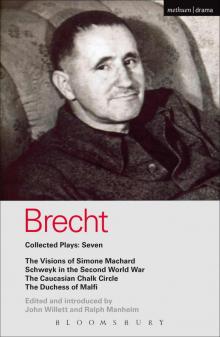 Bertolt Brecht: Mutter Courage und ihre Kinder 7
Bertolt Brecht: Mutter Courage und ihre Kinder 7 Bertolt Brecht
Bertolt Brecht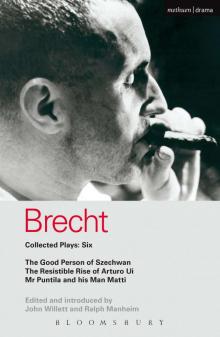 Bertolt Brecht: Mutter Courage und ihre Kinder 6
Bertolt Brecht: Mutter Courage und ihre Kinder 6 Bertolt Brecht: Mutter Courage und ihre Kinder 4
Bertolt Brecht: Mutter Courage und ihre Kinder 4 Bertolt Brecht: Mutter Courage und ihre Kinder 2
Bertolt Brecht: Mutter Courage und ihre Kinder 2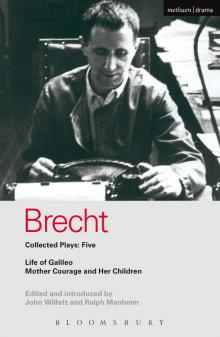 Bertolt Brecht: Mutter Courage und ihre Kinder 5
Bertolt Brecht: Mutter Courage und ihre Kinder 5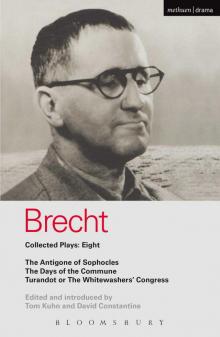 Collected Plays, Volume 4 (Bertolt Brecht: Plays, Poetry & Prose) 8
Collected Plays, Volume 4 (Bertolt Brecht: Plays, Poetry & Prose) 8 Mother Courage and Her Children
Mother Courage and Her Children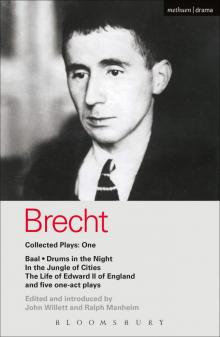 Bertolt Brecht: Mutter Courage und ihre Kinder 1
Bertolt Brecht: Mutter Courage und ihre Kinder 1 Brecht Collected Plays: 3: Lindbergh's Flight; The Baden-Baden Lesson on Consent; He Said Yes/He Said No; The Decision; The Mother; The Exception & the ... St Joan of the Stockyards (World Classics)
Brecht Collected Plays: 3: Lindbergh's Flight; The Baden-Baden Lesson on Consent; He Said Yes/He Said No; The Decision; The Mother; The Exception & the ... St Joan of the Stockyards (World Classics)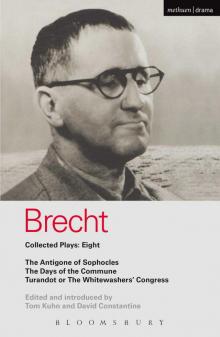 Brecht Plays 8: The Antigone of Sophocles; The Days of the Commune; Turandot or the Whitewasher's Congress: The Antigone of Sophocles , The Days of the Comm (World Classics)
Brecht Plays 8: The Antigone of Sophocles; The Days of the Commune; Turandot or the Whitewasher's Congress: The Antigone of Sophocles , The Days of the Comm (World Classics)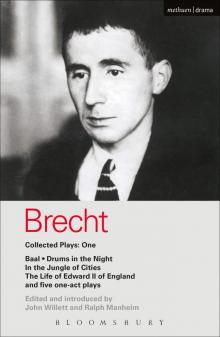 Brecht Collected Plays: 1: Baal; Drums in the Night; In the Jungle of Cities; Life of Edward II of England; & 5 One Act Plays: Baal , Drums in the Night , In the Jungle of Ci (World Classics)
Brecht Collected Plays: 1: Baal; Drums in the Night; In the Jungle of Cities; Life of Edward II of England; & 5 One Act Plays: Baal , Drums in the Night , In the Jungle of Ci (World Classics)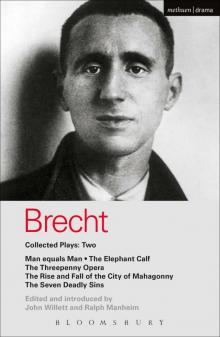 Brecht Collected Plays: 2: Man Equals Man; Elephant Calf; Threepenny Opera; Mahagonny; Seven Deadly Sins: Man Equals Man , Elephant Calf , Threepenny Ope (World Classics)
Brecht Collected Plays: 2: Man Equals Man; Elephant Calf; Threepenny Opera; Mahagonny; Seven Deadly Sins: Man Equals Man , Elephant Calf , Threepenny Ope (World Classics)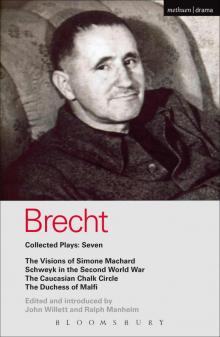 Brecht Collected Plays: 7: Visions of Simone Machard; Schweyk in the Second World War; Caucasian Chalk Circle; Duchess of Malfi (World Classics)
Brecht Collected Plays: 7: Visions of Simone Machard; Schweyk in the Second World War; Caucasian Chalk Circle; Duchess of Malfi (World Classics)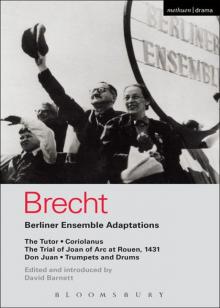 Berliner Ensemble Adaptations
Berliner Ensemble Adaptations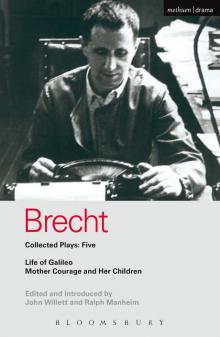 Brecht Collected Plays: 5: Life of Galileo; Mother Courage and Her Children (World Classics)
Brecht Collected Plays: 5: Life of Galileo; Mother Courage and Her Children (World Classics)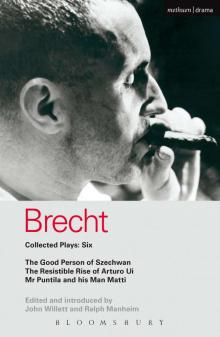 Brecht Collected Plays: 6: Good Person of Szechwan; The Resistible Rise of Arturo Ui; Mr Puntila and his Man Matti (World Classics)
Brecht Collected Plays: 6: Good Person of Szechwan; The Resistible Rise of Arturo Ui; Mr Puntila and his Man Matti (World Classics)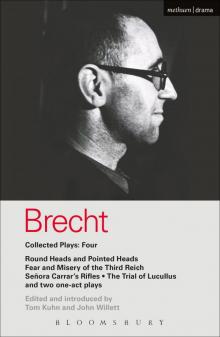 Brecht Collected Plays: 4: Round Heads & Pointed Heads; Fear & Misery of the Third Reich; Senora Carrar's Rifles; Trial of Lucullus; Dansen; How Much Is ... and Misery , Carr (World Classics)
Brecht Collected Plays: 4: Round Heads & Pointed Heads; Fear & Misery of the Third Reich; Senora Carrar's Rifles; Trial of Lucullus; Dansen; How Much Is ... and Misery , Carr (World Classics)